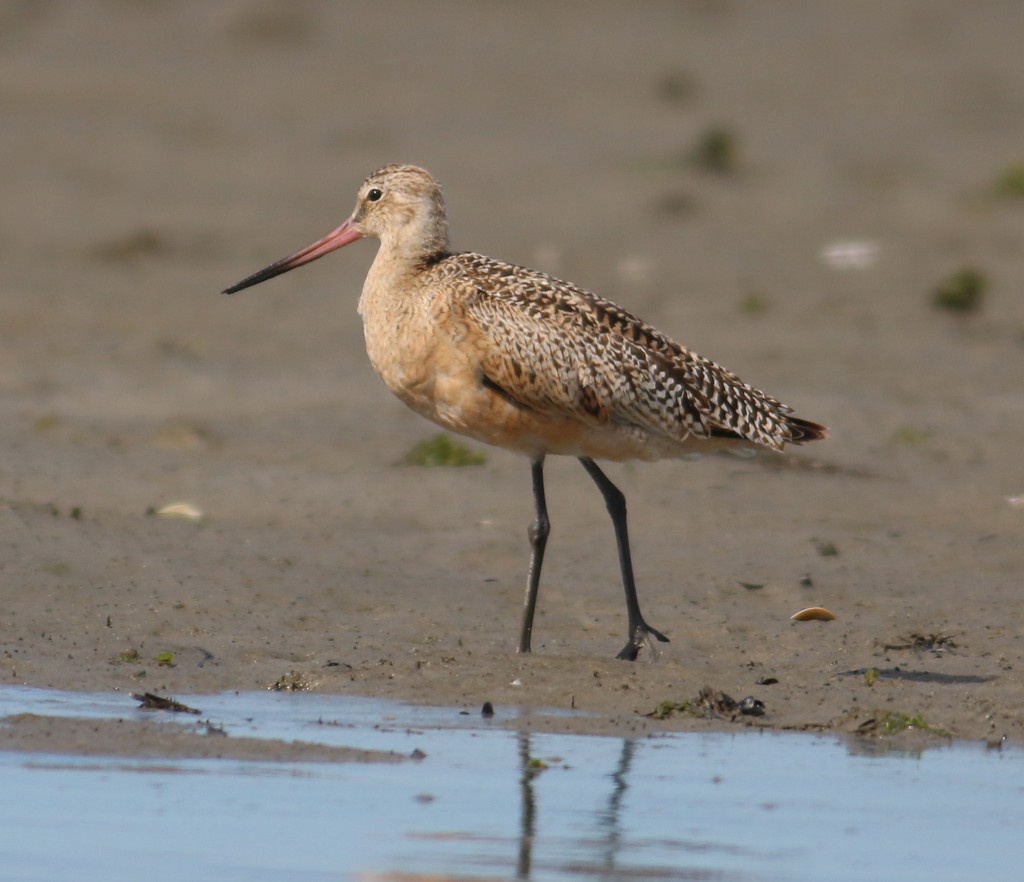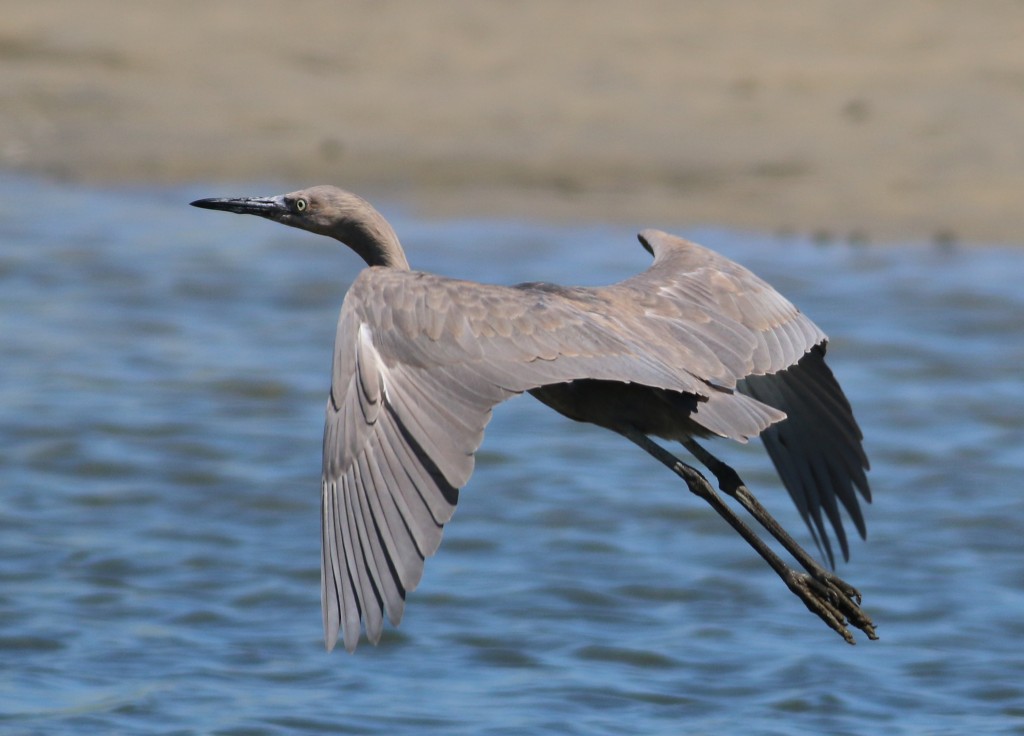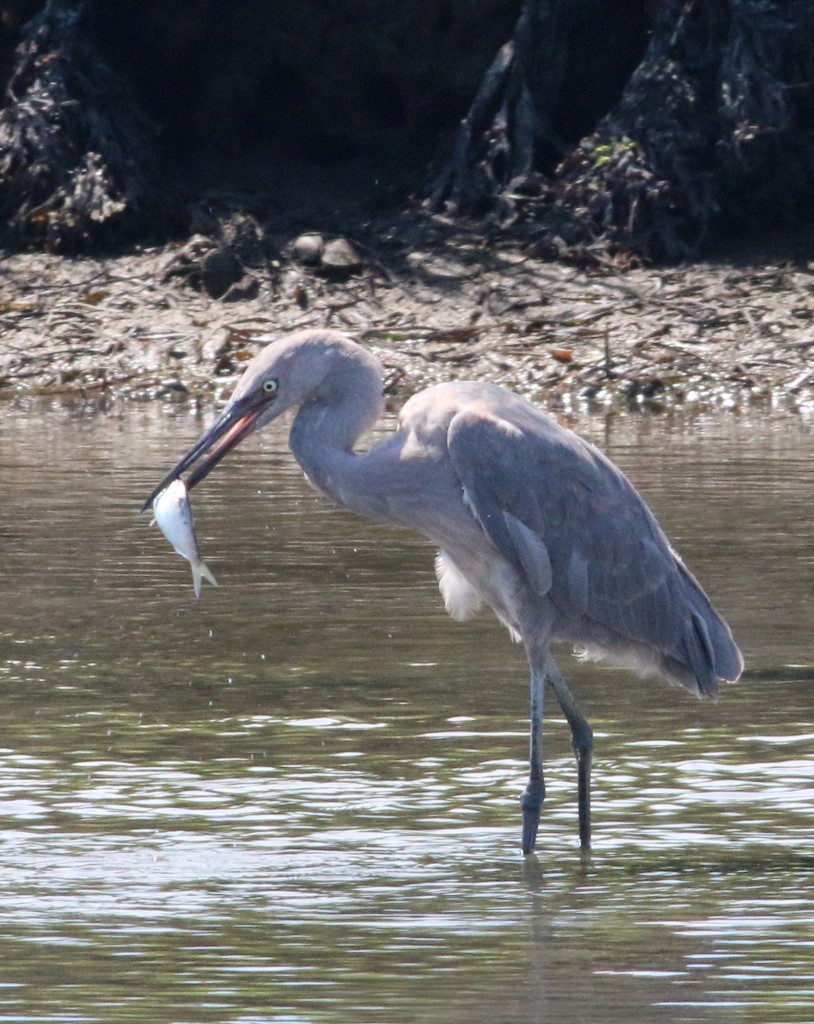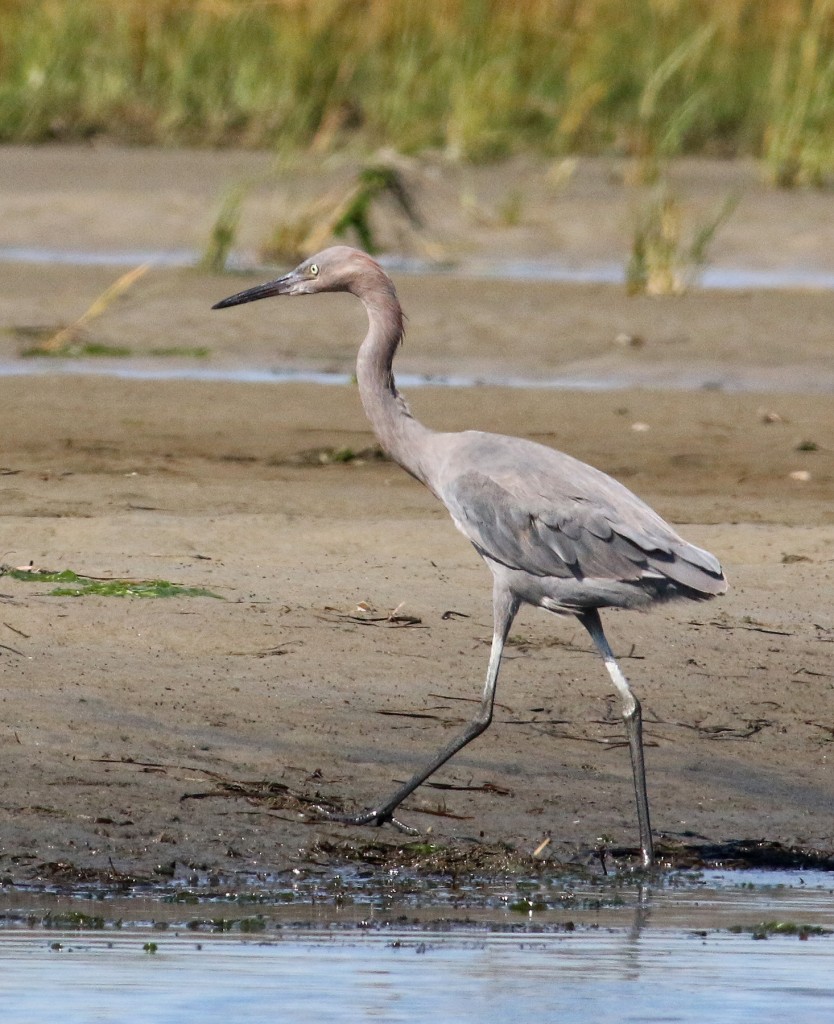Today I went on a canoeing / birding trip with my friend Chris into the Island Beach State Park Sedge Islands, hoping to find some of the nice species that frequent the sand flats in summer. We were not disappointed, finding several dozen Royal Terns, an immature Least Tern, Brown Pelicans, and amongst all the shorebirds, we spotted a pair of Marbled Godwits. It’s tough to beat a Marbled Godwit, especially when it is so cooperative.
Or at least I thought that it would be hard to beat a godwit. As we passed one of the side channels, I noticed a smallish wading bird that struck me as being just too gray. It was far too small for a Great Blue Heron, and I have never seen any Little Blue Herons or Tri-colored Herons that were so gray. In addition, it didn’t have an extremely long bill or a white belly, eliminating Tri-colored. It didn’t look like a Little Blue either, since it had black legs and an all-black bill.
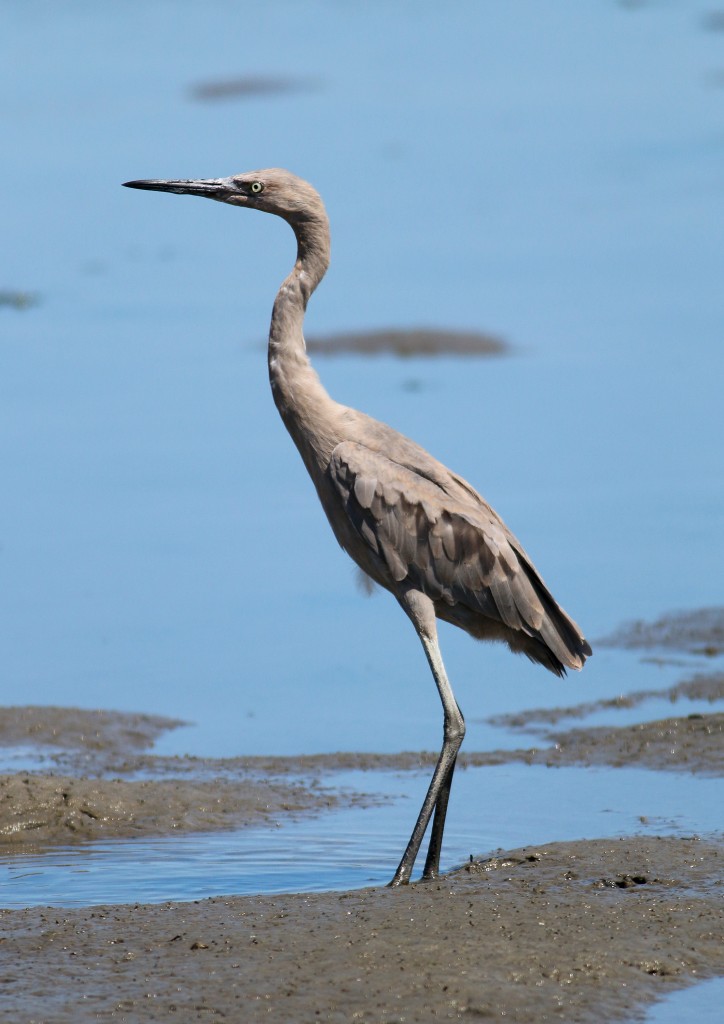
Immature Reddish Egret. Note the black legs, all-black bill, yellow eye, and overall dull gray appearance. It lacks the shaggy necked appearance, which is only seen in breeding adults.
We stopped for photos, and while the bird was feeding in the shallows, it would occasionally raise its wings upward and chase after prey, as you can see in the photo below. Although that behavior was interesting, it wasn’t definitive, as I have seen both Tri-colored Herons and Reddish Egrets using that same approach. So putting it all together, we weren’t sure what species we were seeing, but the photos should help to figure it out after we got home. (I know, I know; I always tell people to bring field guides into the field, and I didn’t do it here for fear of it getting soaked in the canoe. Mea culpa.)
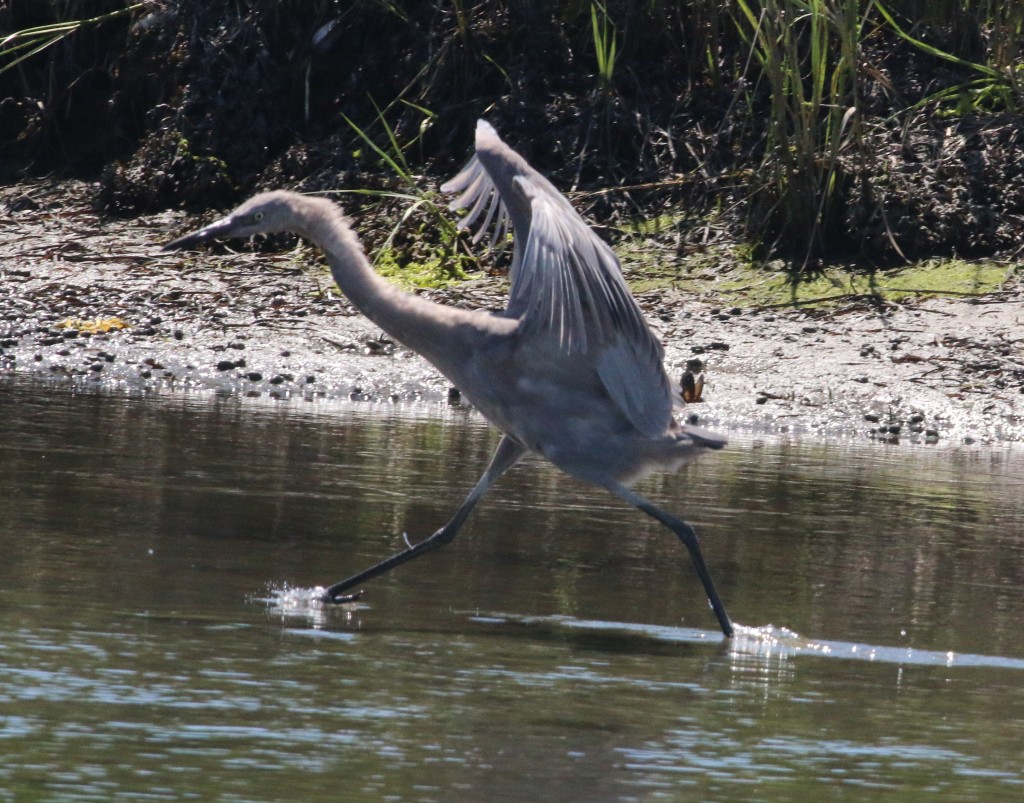
Here it is hunting in typical Reddish Egret style, with its wings held upwards, running after prey. This is very unlike the typical patient feeding style of Little Blue Herons.
After returning back home and examining the photos and comparing them with the field guides, it became apparent that this bird was an immature Reddish Egret. Cool.
So how rare is it for Reddish Egret to appear up here in the northeast? According to the NJ Birds Record Committee records, Reddish Egret had only been reported twice previously in NJ, with both birds being found originally at Brig/Forsythe. The first sighting was on Aug. 23, 1998, and the second one (which was also an immature bird…see here) was at Brig from Aug 24-31 of 2012, and presumably the same bird was seen in the IBSP Sedge Islands by Alex Tongas and his wife on Aug. 31, 2012. So although there aren’t many records, this sighting is consistent with them appearing up here this time of the year. Moreover, over the past 10 years, there are only three eBird reports for Reddish Egret on the east coast north of North Carolina (where they appear annually). In addition to the 2012 NJ bird, one was sighted in Maryland in 2015, and one in Virginia in 2008, with all of these northeastern Reddish Egrets being immature birds. Since 2000 there are only two reports in eBird of Reddish Egret appearing further up the eastern coast of the US, with probably the same bird being found two weeks apart in August 2003 in Rhode Island and MA.
A different way to determine how rare a bird is, is to ask what other rare species have been found at comparable frequency. I was stunned to learn that Reddish Egret had been sighted in NJ less frequently than all of the following species (according to the NJ Birds Records Committee list of accepted sightings, with the number of sightings in parenthesis):
White-tailed Tropicbird (3x)
Wood Stork (16x)
Magnificent Frigatebird (8x)
Anhingha (16x)
Roseate Spoonbill (3x)
Yellow Rail (40x)
Northern Lapwing (4x)
Long-billed Curlew (10x)
Bar-tailed Godwit (6x)
Red-necked Stint (3x)
Little Stint (3x)
Ivory Gull (4x)
Sabine’s Gull (18x)
Whiskered Tern (3x)
Black-chinned Hummingbird (4x)
Calliope Hummingbird (9x)
Black-backed Woodpecker (16x)
Crested Caracara (5x)
Gray Kingbird (15x)
Violet-green Swallow (5x)
Bewick’s Wren (5x)
Mountain Bluebird (3x)
Sage Thrasher (4x)
Green-tailed Towhee (7x)
Black-throated Sparrow (3x)
Golden-crowned Sparrow (6x)
Black-headed Grosbeak (24x)
Hoary Redpoll (4x)
That is a very impressive list, and I would never have expected it to be as uncommon as those species. Knowing that information now, it certainly qualifies as a ‘good bird’.
It turned out to be a pretty good day after all. You just never know what’s around the next bend.
Addendum (Sept. 30, 2016)
The interesting follow-up to this sighting is that this Reddish Egret is now by far the longest-staying Reddish Egret in NJ. The 1998 bird was a one-day wonder and the 2012 bird stayed for nine days. The last eBird report of the 2016 Reddish Egret at Island Beach was on Sept. 28, and then a Reddish Egret was spotted at Forsythe NWR on Sept 30. So if we assume that was the same bird, then it was here in NJ for 45 days! Actually, to be more correct it was not reported for a ~10 day period in early Sept. but was re-sighted repeatedly since then. Jeanine and I returned back to the Sedge Islands three more times since the original sighting and saw it every time. On our last trip there Sept. 26 it appeared that its neck plumage was just beginning to develop some reddish color and shows signs of becoming shaggy. What a great visitor, and by far my birding highlight of 2016.
